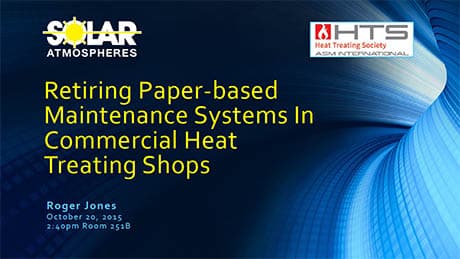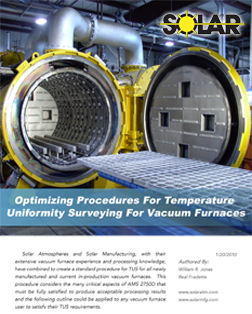CALL: 1-855-WE-HEAT-IT
Vacuum Furnace Maintenance
Preventing Eutectic Reactions and Diffusion Bonding in Vacuum Processing
The purpose of this paper is to explain reactions that can occur during a vacuum processing cycle and different methods of preventing these reactions.
Vacuum Furnace Leaks and Detection Techniques
This article provides a detailed explanation of the various types of vacuum furnace leaks that can occur, where they typically occur, and methods of locating and correcting these problems. Particular safety concerns relating to leak checking will also be discussed.
Dew Point Versus Oxygen Content in Vacuum Processing Part 2
Since the majority of commercial and captive heat treat facilities do not typically operate under controlled environments, the temperature and humidity swings can often be drastic.
Dew Point Versus Oxygen Content In Vacuum Processing
It is well known that accurate measurement of any heat treating atmosphere can have a significant effect on the quality and process yield of heat treated components. Traditionally, dew point analysis has always been the bellwether in determining our heat treating atmospheric conditions.
Retiring Paper-based Maintenance Systems in Commercial Heat Treating Shops
A presentation by Solar's Roger Jones given at the ASM's Heat Treat 2015 trade show about transitioning to paperless maintenance logging.
Optimizing Procedures For Temperature Uniformity Surveying For Vacuum Furnaces
A Temperature Uniformity Survey ( TUS ) for a vacuum furnace to satisfy AMS 2750D must be performed using established procedures and methods that fully meet the requirements of the specification and allows for consistent and more accurate results of actual furnace capabilities. Solar Atmospheres and Solar Manufacturing, with their extensive vacuum furnace experience and processing knowledge, have combined to create a standard procedure for TUS for all newly manufactured and current in-production vacuum furnaces. This procedure considers the many critical aspects of AMS 2750D that must be fully satisfied to produce acceptable processing results and the following outline could be applied to any vacuum furnace user to satisfy their TUS requirements.
Reconditioning Ceramic Insulators
Furnace insulators are designed to electrically and thermally insulate. When they become coated with metals and carbon from high-temperature processing, their electrical resistance is compromised. This article discusses a technique to restore the insulator to its original purpose.
Heat Transfer and Insulation in Vacuum Furnaces
Heat transfer calculations are important in furnace design. Computers can make the work easy, but knowing how to do the calculations by hand gives a better feeling for the problem and provides an appreciation of what actually is happening.
Basic Vacuum Practice by Varian
Basic vacuum practices, a primer and basic introduction for vacuum technicians











